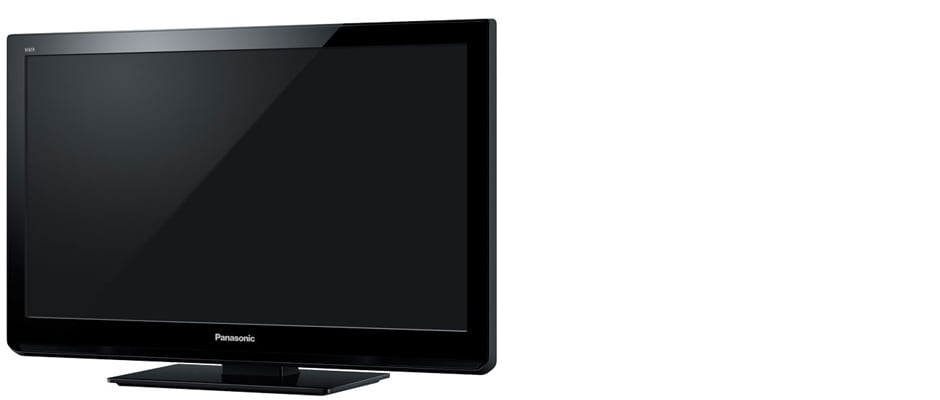Pros
Cons
Introduction
Overall Design
{{section_header}}{{section.name}}{{/section_header}}
Panasonic doesn't take any risky adventures into television design with this model. No color, no special texture, no super slim profile, and no leggy stand are the main features of the {{product.model}}.
It's the TV you've seen before with no surprises at all.
Front
{{section_header}}{{section.name}}{{/section_header}}

Back
{{section_header}}{{section.name}}{{/section_header}}

Sides
{{section_header}}{{section.name}}{{/section_header}}

Stand/Mount
{{section_header}}{{section.name}}{{/section_header}}
The stand on the {{product.name}} is made of some thick plastic with heavy metal attachments. Setting it up for the first time involved more parts and screws than necessary and the whole rig was a little clunky once it was all connected. So many parts, and none of them allow for movement. All of the connections are made in the back of the panel and to access them you will have to swivel the whole TV.

Controls
{{section_header}}{{section.name}}{{/section_header}}
Good old-fashioned buttons are just what we look for on a television. You can find and distinguish them in the dark, they let you know they have been pressed and they won't smudge up your shiny new device.

Remote Control
{{section_header}}{{section.name}}{{/section_header}}
The remote can be programmed to control certain Viera Link devices that can be purchased from Panasonic. We liked this remote because the buttons had great key travel and all of the menu controls were easy to distinguish in the dark.

In the Box
{{section_header}}{{section.name}}{{/section_header}}
Other than a television, we found a remote, batteries for said remote, a stand with too many attachments, a user manual and warranty documents.
Black Level
{{section_header}}{{section.name}}{{/section_header}}
For an LCD screen, with an in-plane switching matrix, this lowest black level reading is strong. IPS displays tend to have trouble producing really rich blacks, often appearing to show dark grey instead of black, but the {{product.name}} does not have this problem. It seems that Panasonic has opted to shift the range of luminance down to achieve this low black level, but at the cost of a high peak brightness as you will see in the next section. More on how we test black level.
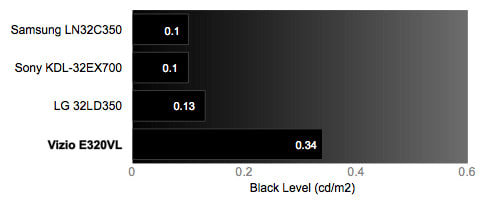
Peak Brightness
{{section_header}}{{section.name}}{{/section_header}}
The comparison models in the chart below show that the {{product.name}} does not match the rest of its class in peak brightness. This low reading means that ambient light will be bright enough to compete with this TV and images may be washed out in a bright room.
IPS screens tend to have a limited spectrum of luminance. The {{product.model}} has a range that emphasizes the black level rather than the brightness, a move that increases the contrast ratio which we discuss in the following section. More on how we test peak brightness.
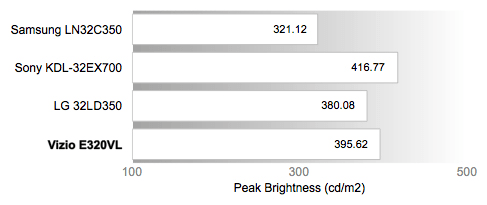
Contrast
{{section_header}}{{section.name}}{{/section_header}}
Contrast ratio results from dividing peak brightness by the deepest black. Each minor change in the black level has a grand effect on the overall ratio because of this equation. A good example is that of the Samsung model in the comparison chart, achieving a top-of-the-line contrast ratio without a very high peak brightness.
The {{product.name}} sacrificed some brightness to get a deeper black for a larger contrast ratio, but the final product will not dazzle anyone. You can see in the chart that similar televisions have much better contrast ratios. IPS display technology tends to hinder the contrast ratio because it is harder to achieve a deep black level necessary for a wide range of values. If you would like to know more about IPS and other panel technologies click here for a great reference article.
The difference in dark and light values is the only way to describe a 3D image in two dimensions, and you will not get the range of values necessary to display a great picture with this television. More on how we test contrast.

Tunnel Contrast
{{section_header}}{{section.name}}{{/section_header}}
In this test, we send various signals from 100% black all the way to 5% black to see if there are drastic changes in the black level produced. With the various auto-dimming functions disabled, the {{product.model}} had no pronounced problems maintaining a consistent black level. More on how we test tunnel contrast.
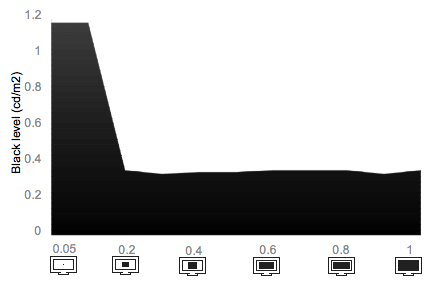
White Falloff
{{section_header}}{{section.name}}{{/section_header}}
Though the peak brightness was not very strong for this TV, the even, horizontal line in the chart below shows that the luminance did not waver given differing amounts of white on the screen. More on how we test white falloff.
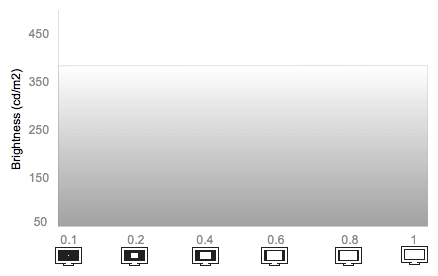
Uniformity
Greyscale Gamma
{{section_header}}{{section.name}}{{/section_header}}
We have discussed the small range of light and dark values, and how it affects the picture, but not how well the television can transition along that range.
The Grescale Gamma graph below represents how well a television can produce each value of grey from black to white. The slope of the line (2.21) is very close to ideal, and does not change drastically meaning that the {{product.model}} shows differentiation between values all along the spectrum in evenly spaced increments.
You will notice that the line is anything but smooth. Each one of the small peaks and valleys represents an inability to produce the correct value from the input signal. So, out of 255 different values, if we asked the {{product.model}} to show us Grey 134, it may show us Grey 133 instead because, for whatever reason, it could not actually give us Grey 134. The numerous bumps in this graph show that many values along this spectrum are excluded all together.
To synthesize all this information, the {{product.name}} will transition from dark to light smoothly with no drastic jumps in brightness. But this TV has a very small range of dark and light values to describe images, and within this diminutive range there are many values that do not get used at all. The result is a TV lacking the range and detail to produce a quality picture. More on how we test greyscale gamma.
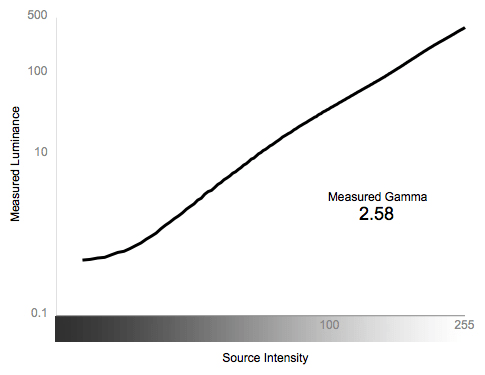
Color Temperature
{{section_header}}{{section.name}}{{/section_header}}
The only problem with color temperature occurred at the dark end of the spectrum. As the signal gets darker, the picture gets increasingly cooler, resulting in a blueish tint to images. That spike at the right side of the chart is a doozy, most people will be able to see dark values looking blue, or more likely purple when images are this dark, a problem endemic to in-plane switching displays.
Check out the LG 37LK450 and the Vizio E320VP reviews for other examples of IPS displays and how this technology affects the color performance. More on how we test color temperature.

RGB Curves
{{section_header}}{{section.name}}{{/section_header}}
Before we discuss the chart below, let's go over what we are looking at. Using 255 values of brightness from darkest to lightest, we test each television to see how well it moves from one value to the next, thus showing the range of colors a television employs to create images.
The ideal graph of each color would be a smooth, curved line that reaches from 0 to 100% brightness without any flat parts, demonstrating that each given value is produced differently than any other and that the entire range is used. Each of the three primary colors should be exactly in line with the others because they are all tested using the same 255 values of brightness.
We fiddled with the various settings and our calibration software to get the best set of colors, and what you see below is the best this TV could do. Though the green line looks like the outlier, the red and blue lines are actually too shallow, meaning red and blue values are mostly too dark until they get bright too quickly. The blue line lacks smoothness. Each one of the jumps in this line indicate values that were different than the input signal. The red line is smoother than the blue one, but it increases in brightness very quickly towards the right side of the chart. Bright red values will be brighter than intended. Green starts well, but gets overly bright in the middle, compensates by flattening a little, and then curves again towards the end losing detail all along the way.
Essentially, the primary colors, and thereby all of the colors, will not be displayed as intended. Directors and Editors spend lots of time tuning their images, color correcting them for perfection, and the {{product.model}} cannot reproduce these images as created. More on how we test RGB curves.

The strips below are visual representations of the graph above. Looking at the green strip from right to left, you can see that it jumps from almost black to middle green without the smoothness you see in the ideal response.
Motion Performance
{{section_header}}{{section.name}}{{/section_header}}
In-plane switching displays have very quick response times and are able to handle motion more smoothly than their twisted nematic counterparts. This Panasonic, with only 60Hz of processing power, displays motion like a much more expensive television.
This entry-level set didn't need fancy motion processing features to interpolate extra frames. Instead, the {{product.model}} screen refuses to lag with the super speedy response time of an IPS display that quickly changes one image to the next without a thought to overdrive processing.
Photos lost little detail in motion. Faces were recognizable, fine details like ridges on wainscoting were unaffected, and only the most intricate parts of the image were blurred while in motion. Sharp objects in motion showed only a little of the standard jagged edges and there were almost no afterimages of colors. Only high frequency, high contrast patterns were noticeably affected by motion, with significantly more jagged edges, but there were no color artifacts and at no time did any of the images warp into different shapes while moving. More on how we test motion performance.
3:2 Pulldown & 24fps
{{section_header}}{{section.name}}{{/section_header}}
The {{product.name}} comes with a 3:2 Pulldown mode that helped it perform in our 24fps tests. Because this mode is not a true 24fps mode, rather a 3:2 Pulldown, 24fps content was well displayed, but not perfect. There was some flickering in the SMPTE patterns we moved across the screen and we noticed some juddering and mosquito crawl in actual content. These discrepancies were not immense however, the 3:2 Pulldown mode on the {{product.model}} works rather well. More on how we test 3:2 pulldown and 24fps.
Resolution Scaling
{{section_header}}{{section.name}}{{/section_header}}
The {{product.name}} does not quite have a 720p resolution. Instead, it conforms to a computer screen standard of 1366 x 768 pixels, which does not match the 720p HD standard. The {{product.model}} has to scale a 720p picture to fit its "720p" native screen. In fact, 720 does not scale to 768 very easily and clipping problems called overscan occur even in its native resolution. Even with various screen sizes, there was no way to eliminate the 4% overscan evident at all resolutions. Given these problems natively, scaling to other resolutions resulted in more problems, most notable in 1080p. More on how we test resolution scaling.
480p
More than half of our moiré patterns were banded together at this resolution, but our high contrast patterns were well displayed and text was readable down to the smallest font.
720p
Normally we wouldn't bother talking about a television's native resolution, but 720p was not easy for this TV. Almost every one of the high frequency patterns we put up were banded together instead of intricately differentiated. To demonstrate, a tightly striped shirt will appear as a hazy mass of thick lines on this screen, especially at 720p. Only medium to large sized fonts were reasonably legible at this resolution.
1080p
1080p requires the most work out of a television because there are more pixels to track and scale to the matrix on the display. Yet for some reason, high frequency patterns were not as awfully produced as they were at 720p. Text was a disaster though, only the largest print was legible.
Formats
{{section_header}}{{section.name}}{{/section_header}}
The {{product.name}} displays all NTSC standard formats and produces images 720p natively on a 768 x 1366 pixel matrix.
Viewing Angle
{{section_header}}{{section.name}}{{/section_header}}
The main advantage of IPS is the viewing angle. The technology was developed in response to rapid loss of contrast and color on typical LCD screens when viewed at an angle. Moving side to side with the {{product.name}}, you won't notice any graying or inverting of colors and the contrast ratio (low as it may be) is unaffected up to 43º off center.
Side-to-side is a breeze for the {{product.model}}, but be wary of the vertical viewing angle. Very quickly will you lose contrast if you change the height at which you watch this TV. If you are planning to mount it on a wall, make sure you have a way to angle it directly at the intended seating area.
The other models in this comparison are IPS displays as well, except for the Samsung which has a standard viewing angle for a twisted nematic LCD screen, significantly narrower than IPS.

Reflectance
{{section_header}}{{section.name}}{{/section_header}}
We shine LED lights at the screen of our televisions as a test of how the lighting in a room will affect your viewing. These LEDs were reflected back at us strongly. The screen of the {{product.model}} didn't seem to diffuse the light very well. Changing the angle of the light made little difference. With a screen that does not get very bright to begin, external lighting was very distracting, easily able to take precedence over the brightness of the screen.
Video Processing
{{section_header}}{{section.name}}{{/section_header}}
A small selection of video processing modes are thrown in to give this TV a modern feel. These modes either make little difference or such a big one that the change will distract from the content you are watching.
Calibration
{{section_header}}{{section.name}}{{/section_header}}
We calibrated the {{product.model}} to produce the optimal range of color and luminance possible for this TV using DisplayMate software and several, scripted tests. Without too many settings, this TV is easy to calibrate using the table below.

All of our calibration is done in conjunction with the DisplayMate software.
](http://www.displaymate.com/)
Video Modes
{{section_header}}{{section.name}}{{/section_header}}
Only a few video modes offer calibrations for different situations.
Connectivity
{{section_header}}{{section.name}}{{/section_header}}
The handful of the ports can be found on the back, left side of the {{product.model}}. You really do not get much back there: two HDMI ports, one component and composite each, a VGA port for the computer that shares its audio with the Component port, meaning no 3.5mm audio in. There's a spot for a cable or antenna to plug in, a digital optical out for connections to sound systems, and the only curve ball, an SD card living alone on the left side of the display.

We find this collection of connections to be a little strange. To begin, there is no analog audio out, not even borrowed from another analog connection because there are none that lead out. So, if you have an analog speaker set ready to go, you will now need to buy a receiver with a digital connection.
Also, there are no USB ports, but an SD card slot instead. Panasonic is a big manufacturer of SD cards, so though a lack of a USB port is going against the stream of modern televisions, this relationship makes sense. The SD slot got us hopeful, thinking about how awful the entry-level USB menu interface tends to be.
Plenty of bargain televisions will claim to be able to play movies, music and photos in a slide show with all sorts of interesting features. When you actually insert a thumb drive, you discover that most of your videos, photos, music, and devices are in the proper formats but are for some reason non-compatible and the system is so clunky that you make plans never to use it again. We investigated the SD media UI on this Panasonic in our =href "http://stage.televisioninfo.com/content/Panasonic-TC-L32C3-LED-LCD-HDTV-Review/Multimedia-and-Internet.htm">Multimedia section. We were not that happy about it.
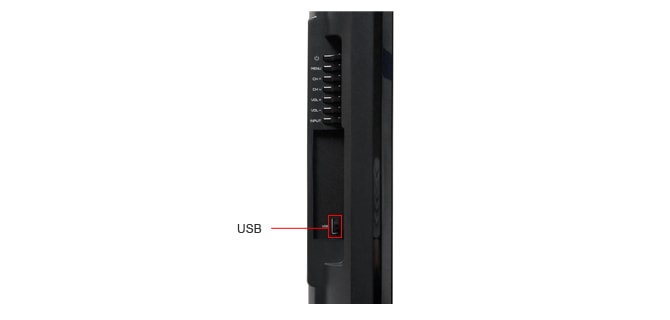
Placement
{{section_header}}{{section.name}}{{/section_header}}
The ports are in the usual area, but a highly static stand with heavy metal attachments means you will be turning the whole television to make new connections.
Audio Quality
{{section_header}}{{section.name}}{{/section_header}}
10W speakers are actually better than what are found on most small-sized, entry-level televisions. You can certainly watch television with what they provide, but don't expect the quality, booming sound you get with an external speaker set. Remember that there are no analog audio out connections, so if you do get speakers, make sure they can connect via SPDIF.
There is a surround sound mode on this {{product.name}}, but it's not aptly named. Engaging the surround mode does seem to improve the quality of the audio, going from canned to more realistic, but any sense of the sound coming from behind or the sides was not there.
Menu Interface
{{section_header}}{{section.name}}{{/section_header}}
With few advanced features, the menus on the {{product.name}} are elementary. Pressing menu brings up a left side bar with options for picture settings, audio settings, sleep timer, channel locking, closed captioning and system settings for time, date and other malarkey.

We noticed that in the Aspect Adjustments menu that "Full" was the best option for retaining the most amount of picture on screen. Set to "Full", there was 4% overscan all around, but any other setting only increased this percentage up to a possible 20%.

Instruction Manual
{{section_header}}{{section.name}}{{/section_header}}
The instruction manual for the {{product.model}} has a table of contents and an index to help you get around. Aesthetically, it's not the most beautiful thing on paper and the photos aren't so helpful. More importantly, the specifications section is slightly incomplete and some of the marketing terms, like "Super Resolution" from the box and the Panasonic website are not explained at all.
You can find a digital copy of the manual by clicking here.

A manual for so many TV models, they have to be further categorized by type.
Local Media Playback
{{section_header}}{{section.name}}{{/section_header}}
The SD card slot is the only extra feature on the {{product.name}}. The interface is easy to understand and it works well for individual photos. The slide shows are painfully slow. Hitting "Next" on the remote, it takes a full eight seconds before the next photo pops up. To put that in perspective, if you can stay on a bucking bronco for as long as it takes to the {{product.model}} to load a new photo, you could be the next rodeo champion.
Also, Panasonic claims that you can put music to these slide shows. Sounds great, all you have to do is set up the photos and select the...music? How are MP3s expected to make their way onto this television? There is no stock music, so Panasonic must be saying that you are allowed to be playing music in the background while you look at photos on the {{product.model}}. That makes sense.
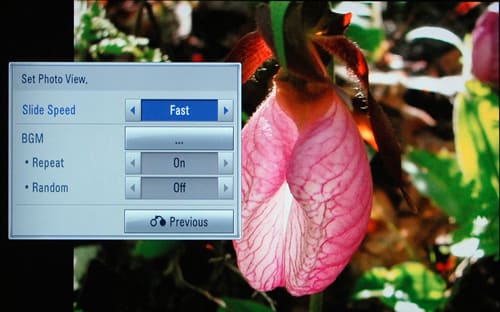
Power Consumption
{{section_header}}{{section.name}}{{/section_header}}
The screen on the {{product.name}} doesn't get bright enough for a reasonable contrast ratio, there are no internet features or overdrive functions that would require a more advanced processor, and yet it still requires 79 Watts to power on average. Look at the comparison chart below and you will see that this Panasonic costs more to use per year than a television that is five inches larger. Still, $17.78 for the year isn't bad, nor will it break the bank, but in this age of green technology, we wonder where all the power goes?
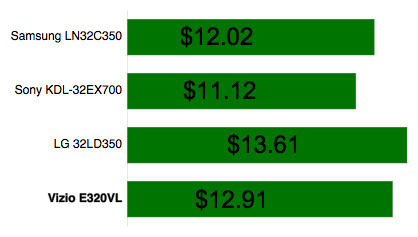
Value Comparison
{{section_header}}{{section.name}}{{/section_header}}
These two televisions offer similar ports, color and motion performance, and wide viewing angles. The Vizio is a little more expensive, the extra money pays for a significantly better contrast ratio and a super thin screen.
Blacks & Whites
{{section_header}}{{section.name}}{{/section_header}}
The {{product.name}} has such a sad contrast ratio that it's not going to beat out any competing model. A no contest contrast ratio win goes to the Vizio.

Color Accuracy
{{section_header}}{{section.name}}{{/section_header}}
The Vizio had noticeable color temperature aberrations over a wider section of the spectrum than the Panasonic, so you will see a minor blue tint to mid-range greys all the way to black. The Panasonic did not have this problem, but its color temperature sky rockets into the cool at the darkest end of the spectrum. The tinting will be significantly more noticeable in shadows on the Panasonic than any picture on the Vizio.
Surprisingly, the Vizio was worse at matching the ideal color response. Neither of these televisions will give you reasonable color performance.
Motion
{{section_header}}{{section.name}}{{/section_header}}
Both models here use in-plane switching displays to produce images which have quick response times, making the screens great for showing moving objects. The Vizio, even with a few overdrive processing features, did not quite match up to the Panasonic.
Viewing Effects
{{section_header}}{{section.name}}{{/section_header}}
These two screens have almost identically wide viewing angles. The Panasonic edges out the Vizio because it retained colors so well when moving side-to-side.
Connectivity
{{section_header}}{{section.name}}{{/section_header}}
The port connections are about the same on these two televisions. The Panasonic went with an extra SD card slot, whereas the Vizio opted for a USB media port. Both of these media ports are underwhelming additions, thrown in for the marketing crowd to be able to write something about a bare-bones idiot box.
Value Comparison
{{section_header}}{{section.name}}{{/section_header}}
For a similar price, this LG will give you a better set of colors, a great contrast ratio, more ports and five extra inches of screen. If viewing angle is your only concern, then the Panasonic is your choice, every other consideration should be given to the LG.
Blacks & Whites
{{section_header}}{{section.name}}{{/section_header}}
This LG has a fantastic range of dark and light values giving it a contrast ratio over 1000:1, a great score for televisions at any level or price point. Multiplied three times, the contrast ratio on the Panasonic is still not as good as the LG.

Color Accuracy
{{section_header}}{{section.name}}{{/section_header}}
Both of these televisions employ IPS displays and demonstrate some of the common problems inherent to the technology. One of these problems is a purplish tinting to dark values that occurs when the color temperature gets radically cool as the input signal moves to black. You can see that the Panasonic spikes more drastically than the LG, and scores worse as a result.
Motion
{{section_header}}{{section.name}}{{/section_header}}
It would be hard to choose a winner here, both use the same technology to score very well in a test that is somewhat subjective.
Viewing Effects
{{section_header}}{{section.name}}{{/section_header}}
For an IPS display, the LG had a bit of a narrow viewing angle. The {{product.name}} is the clear victor.
Connectivity
{{section_header}}{{section.name}}{{/section_header}}
The Panasonic we reviewed here did not offer anything special in the way of ports. The LG on the other hand gave us a host of regular and irregular connections all of which are useful. Variety is the important notion and LG certainly delivered.
Value Comparison
{{section_header}}{{section.name}}{{/section_header}}
The Samsung UN32D4000 is significantly more expensive than our Panasonic here, enough to be a limiting cost at this level of television. Your extra dollars pay for ports and a contrast ratio that blows this Panasonic out of contention. The cheaper Panasonic has a better viewing angle and better motion performance, so you may want to consider it if you are looking for an easy extra television for watching sports.
Blacks & Whites
{{section_header}}{{section.name}}{{/section_header}}
It's hard to compare numbers like 5500 to 360 without using childish words or hyperbole. The Samsung's contrast ratio is freaking awesome, the Panasonic's, like, totally sucks.

Color Accuracy
{{section_header}}{{section.name}}{{/section_header}}
Colors were about the same on these two sets. The shadows on the Panasonic look a little blue, and a little orange on the Samsung.
The color response curves were about the same as well, with undersaturation and oversaturation being problems for both sets. The Samsung's curves were smoother however, showing that more values of color are used for greater detail.
Motion
{{section_header}}{{section.name}}{{/section_header}}
The Samsung in this comparison uses a classic twisted nematic pixel matrix to display images whereas the Panasonic uses an in-plane switching display. Twisted nematic displays have a slower response time than in-plane switching ones, and therefore will generally perform worse in motion tests, as you see here.
Viewing Effects
{{section_header}}{{section.name}}{{/section_header}}
Another win for in-plane switching displays is the wider viewing angle. The Panasonic overwhelms the Samsung with its nearly obtuse viewing angle.
Connectivity
{{section_header}}{{section.name}}{{/section_header}}
The Samsung carries more ports than the Panasonic, specifically a total of four HDMI ports for connecting a bunch of newer devices. Instead of an SD card slot, the Samsung has a USB connection that works. It can play music, photos, and movies using an interface that is easy and, get this, actually functional! Go with the Samsung if you want to experience over-the-top video and your own slide shows.
Conclusion
The {{product.name}} ($399 MSRP) is Panasonic's lowest-end television for the year 2011. With an in-plane switching display, designed for optimized viewing angle, and added benefits of speedy pixel response time, this Panasonic would seem to be a great secondary television, especially for sports watching. Many people can watch at the same time and motion will be displayed crisply.
It is possible that viewing angle and response time are the only two aspects that are important to you, but considering the laundry list and severity of weaknesses attached to the {{product.name}}, we think you should look elsewhere.
This TV uses a sad set of colors that do not match up to the HDTV standards and do not transition well from light to dark. The {{product.model}} had a hard time with our resolution tests because the non-standard 720p resolution (768 x 1366, a format borrowed from computer monitors) overscans every resolution by 4% all around the picture. Worst of all is the contrast ratio of 368:1, which tells us that the {{product.model}} does not have the breadth of light and dark values necessary for a quality picture. To the eyes, the screen is noticeably dim with the backlight at maximum, the color palate seems to come from a carnival and most types of high frequency pattern smudges together.
We cannot recommend this television. We always try to think of the niche consumer that would find a certain feature useful, or a price point to match highlights of quality, but the {{product.name}} managed to defeat all of our theoretical buyers. The SD card slot was a nice touch for camera wielding slideshow enthusiasts, but the interface was so bad that the idea was thrown out. With good motion processing and a wide viewing angle, a secondary sports television was an option, but the colors are so bad you may not recognize your home team and fine detail is lost due to a wonky number of pixels forcing resolution problems. We are certain that if you went to the store with $400, you could find a more suitable television, whatever your needs.
Model Series Comparison
{{section_header}}{{section.name}}{{/section_header}}
The {{product.model}} series contains this one model, an entry-level, in-plane switching display with a small set of ports and no advanced features.
Panasonic also offers a 19 inch model in the C30 series that uses an IPS display and offers a similar set of features, with one fewer HDMI port, for about $250.
Photo Gallery
{{photo_gallery "Front Tour Image", "Back Tour Image", "Sides Tour Image", "Stand Photo", "Controls Photo", "Remote Control Photo", "Connectivity Tour Image 1", "Connectivity Tour Image 2", "Connectivity Extra Photo", "Menu Main Photo", "Menu 2 Photo", "Internet Features 1 Photo", "Internet Features 2 Photo", "Internet Features 3 Photo", "Local Media Playback 1 Photo", "Local Media Playback 2 Photo"}}
Ratings & Specs
{{manufacturer_specs_table}}
Meet the tester
Christian Sherden is a valued contributor to the Reviewed.com family of sites.
Checking our work.
Our team is here to help you buy the best stuff and love what you own. Our writers, editors, and experts obsess over the products we cover to make sure you're confident and satisfied. Have a different opinion about something we recommend? Email us and we'll compare notes.
Shoot us an email